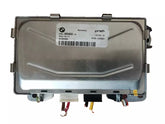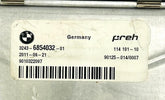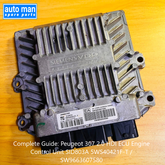كيفية استبدال وصيانة ضاغط مكيف الهواء في سيارتك مرسيدس: دليل شامل للقيام بذلك بنفسك
إذا كانت سيارتك مرسيدس-بنز تنفث هواءً دافئًا، أو تُصدر أصواتًا غريبة عند تشغيل مكيف الهواء، أو لا يعمل قابض ضاغط مكيف الهواء، فقد يكون السبب عطلًا في ضاغط مكيف الهواء. بدلًا من التسرع في الذهاب إلى ميكانيكي، سيرشدك هذا الدليل إلى كيفية استبدال ضاغط مكيف الهواء بنفسك، بالإضافة إلى نصائح مهمة للحفاظ عليه لأدائه طويل الأمد.
تم كتابة هذه المقالة لمالكي سيارات مرسيدس بنز في جميع أنحاء الولايات المتحدة وأوروبا وأستراليا الذين يريدون فهم وصيانة سياراتهم دون تكاليف غير ضرورية.
ماذا يفعل ضاغط تكييف الهواء في سيارة مرسيدس؟
ضاغط مكيف الهواء هو قلب نظام تكييف الهواء. فهو يضغط ويوزع مادة التبريد عبر النظام لتبريد داخل السيارة. وبدونه، لا يعمل نظام تكييف الهواء. من علامات الأعطال الشائعة:
-
الهواء الدافئ القادم من الفتحات
-
أصوات نقر أو طحن عند تشغيل مكيف الهواء
-
قابض الضاغط غير النشط
-
تسربات مرئية حول الضاغط
أرقام قطع ضاغط تكييف الهواء الأصلية لمرسيدس
في Automan Spare Parts، نقوم بتزويدك بأرقام أجزاء ضاغط OEM الأصلية التالية:
-
A0008303002
-
A0008302602
-
A0008302002
-
A0008302402
تُستخدم هذه الأجزاء عادةً في:
-
الفئة-E (W212)
-
فئة CLS (C218)
-
الفئة-S (W221)
-
الفئة-M (W166)
-
GLE وGL-Class (X166)
دليل خطوة بخطوة: كيفية استبدال ضاغط مكيف الهواء في سيارتك مرسيدس
قبل البدء بعملية الاستبدال، تأكد من تفريغ سائل التبريد بواسطة فني مرخص. يُعدّ إطلاق سائل التبريد في الهواء أمرًا غير قانوني وخطيرًا.
الأدوات والمواد المطلوبة
-
مجموعة مفاتيح المقبس
-
مفكات البراغي
-
ضاغط تكييف جديد OEM
-
أداة الحزام الثعباني
-
معدات استعادة المبردات
-
مضخة التفريغ ومجموعة مقياس المشعب
-
حلقات O وزيت PAG المعتمد من الشركة المصنعة
-
قفازات السلامة ونظارات السلامة
الخطوة 1: افصل البطارية
ابدأ دائمًا بفصل الطرف السالب للبطارية. هذا يمنع حدوث تماس كهربائي ويضمن السلامة أثناء الإصلاح.
الخطوة 2: إزالة الحزام الثعباني
استخدم أداة حزام سربنتين لتخفيف الشد وإزالة الحزام من بكرة ضاغط التيار المتردد. دوّن ملاحظة أو التقط صورة لمسار الحزام لإعادة التركيب.
الخطوة 3: إخلاء نظام تكييف الهواء
استخدم معدات احترافية لإزالة سائل التبريد من النظام. يُفضّل القيام بذلك في مركز معتمد لإصلاح السيارات أو بواسطة فنيّ مرخص.
الخطوة 4: إزالة ضاغط التيار المتردد
حدد مكان ضاغط التيار المتردد (عادةً ما يكون مُركّبًا في الجزء الأمامي السفلي من المحرك). افصل الوصلة الكهربائية وأزل وصلات خط التبريد. ثم أزل مسامير التثبيت وأخرج الضاغط بحرص.
الخطوة 5: تحضير الضاغط الجديد
أضف الكمية والنوع المناسبين من زيت PAG إلى الضاغط الجديد كما هو موضح في دليل خدمة سيارتك. استبدل الحلقات الدائرية القديمة بأخرى جديدة على أنابيب التبريد.
الخطوة 6: تثبيت الضاغط الجديد
ثبّت الضاغط الجديد في مكانه. أعد توصيل أنابيب التبريد والموصل الكهربائي بإحكام.
الخطوة 7: إعادة تثبيت الحزام السربنتيني
أعد تركيب الحزام وفقًا للمسار الصحيح. استخدم أداة الشد للتأكد من تثبيته بالشد الصحيح.
الخطوة 8: تنظيف نظام التيار المتردد بالمكنسة الكهربائية وإعادة شحنه
استخدم مضخة تفريغ لتفريغ الهواء والرطوبة من نظام التكييف لمدة 30 دقيقة على الأقل. ثم أعد شحن النظام بالنوع والكمية المناسبين من سائل التبريد. تستخدم معظم طرازات مرسيدس سائل التبريد R134a أو R1234yf - راجع دليل المالك.
الخطوة 9: اختبار النظام
أعد توصيل البطارية وشغّل السيارة. شغّل مكيف الهواء وتأكد من:
-
الهواء البارد قادم من الفتحات
-
يتم تشغيل قابض الضاغط
-
لا يوجد أي ضوضاء أو تسريبات غير عادية
نصائح الصيانة لإطالة عمر ضاغط التيار المتردد الخاص بك
يمكن أن تؤدي الرعاية المناسبة إلى إطالة عمر الضاغط الخاص بك ومنع الإصلاحات المكلفة:
1. قم بتشغيل نظام تكييف الهواء بانتظام
حتى في فصل الشتاء، قم بتشغيل مكيف الهواء لبضع دقائق كل أسبوع للحفاظ على تشحيم النظام ومنع جفاف الأختام.
2. مراقبة مستويات سائل التبريد
يؤدي انخفاض مستوى سائل التبريد إلى إجهاد الضاغط وقد يؤدي إلى عطل. افحص مستوياته مرة واحدة على الأقل سنويًا.
3. استخدم السوائل المناسبة
استخدم فقط سائل التبريد ونوع الزيت الموصى بهما من قِبل الشركة المصنعة. قد يؤدي استخدام سوائل غير مناسبة إلى إتلاف الأختام والمكونات.
4. تغيير فلاتر هواء المقصورة
يؤدي انسداد الفلتر إلى تقييد تدفق الهواء وإجبار نظام تكييف الهواء على العمل بجهد أكبر، مما يضع ضغطًا على الضاغط.
5. فحص حزام القيادة
قد يؤدي تآكل أو انزلاق الحزام إلى تعطل الضاغط. استبدله عند أول علامة على التشقق أو التآكل.
اطلب ضواغط تكييف مرسيدس الأصلية من قطع غيار أوتومان
نقدم ضواغط تكييف هواء أصلية عالية الجودة من مرسيدس-بنز، متوافقة مع مختلف الموديلات. قطع غيارنا مختبرة، ومدعومة بالضمان، ومتاحة للشحن الدولي إلى:
-
الولايات المتحدة
-
فرنسا
-
إسبانيا
-
المكسيك
-
ألمانيا
-
أستراليا
قم بزيارة www.AutomanSpareParts.com لاستعراض مخزوننا والحصول على أسعار الجملة.
خاتمة
استبدال ضاغط مكيف الهواء في سيارتك مرسيدس-بنز لا يتطلب تكاليف عمالة باهظة. باستخدام الأدوات والتجهيزات المناسبة، يمكنك القيام بذلك بنفسك والحفاظ على سيارتك تعمل بسلاسة. اتبع الخطوات الواردة في هذا الدليل بعناية، واتخذ الاحتياطات اللازمة لضمان استمرار ضاغطك الجديد لسنوات.
إذا كنت بحاجة إلى مساعدة في العثور على الجزء المناسب لسيارتك، فاتصل بفريق الدعم الخاص بنا باستخدام رقم VIN الخاص بك وسوف نقوم بمطابقة ضاغط OEM الصحيح لك.







